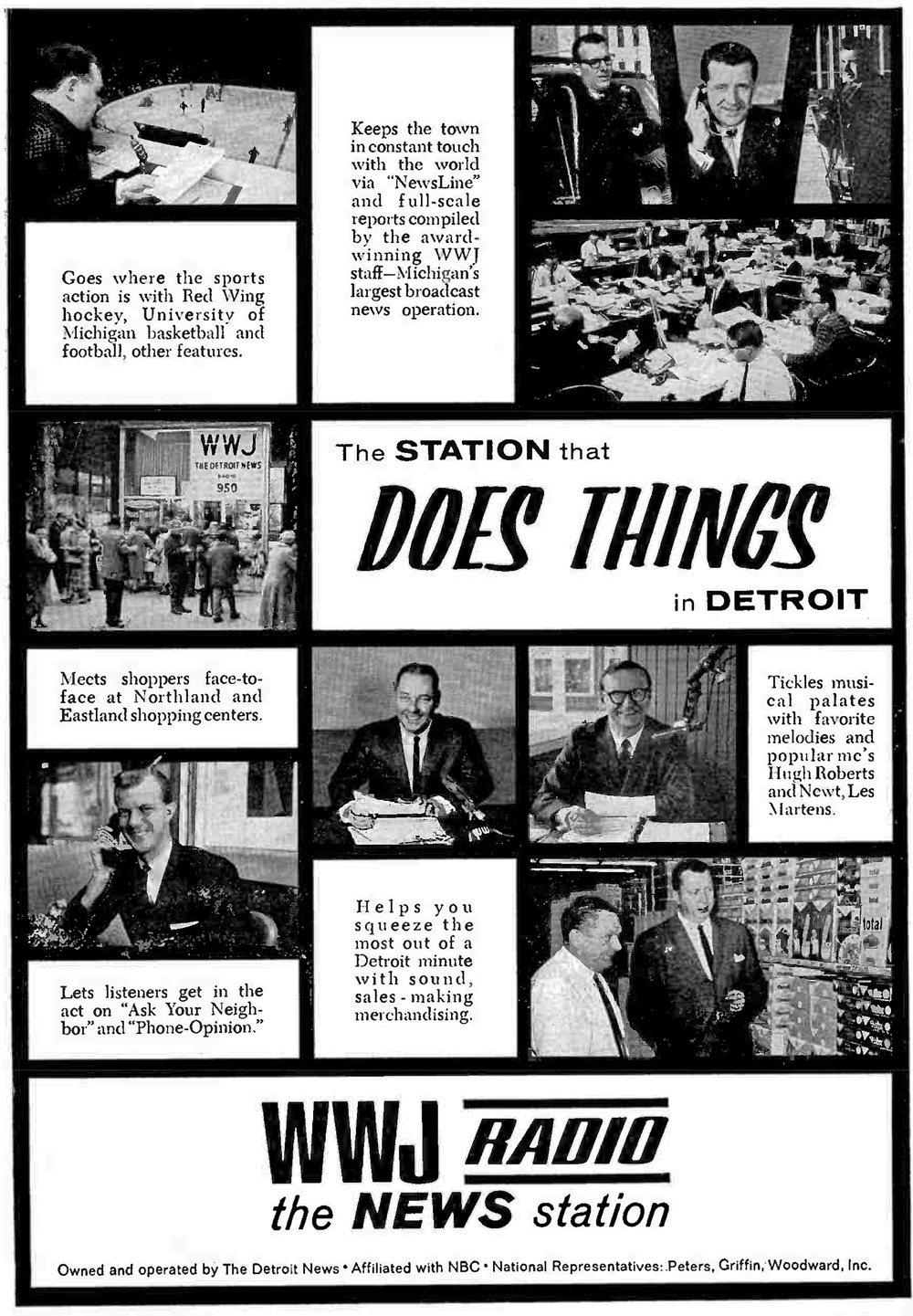
![]()
 From the MCRFB radio news scrapbook: 1942
From the MCRFB radio news scrapbook: 1942
WWJ WORKS UP SKED OF DEFENSE SHOWS
DETROIT, Feb. 28.— Brief new programs to bring the problems of national defense home to listeners and tie in with support for the armed services are being started on WWJ. Tendency is to work the new trend out experimentally and in small bits, rather than in pretentious programs, thereby minimizing upsets to existing schedules.
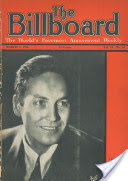
Series of letters received from men in the service, sent to relatives, is being presented dally in a program by Ty Tyson, Man in the Service. Listener response appears strong on this program.
Further service tie-ups starts March 10, when Paul Williams goes on four-times a-week as Victory Reporter. Program is being scripted to cover brief human interest and oddity stories from the services, and limited to a five-minute spot at present.
Third program, Defend Detroit, goes on for 10 minutes five afternoons a week, and is worked out with local CCD officials to plug the immediate need of the day. One authority is built up for each day’s broadcasts and the entire five are brought in on Fridays for a half-hour studio show, not broadcast, but staged as a round table of the week’s progress in civilian defense. END
(Information and news source: Billboard; March 7, 1942).
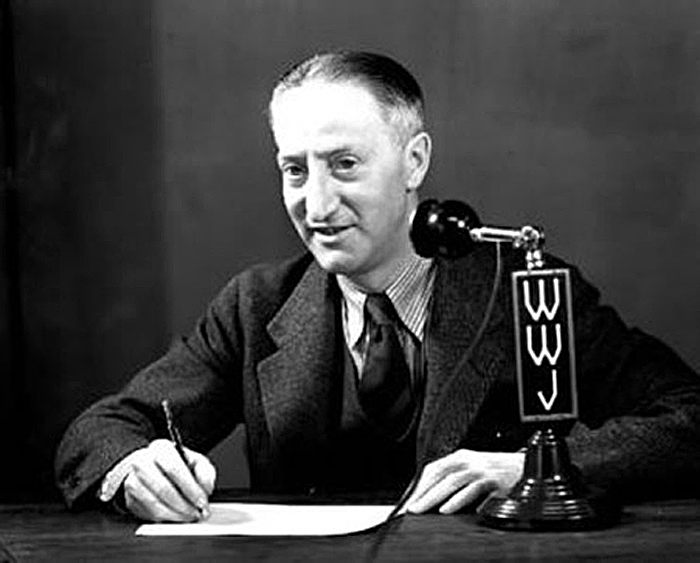
 From the MCRFB radio news scrapbook: 1942
From the MCRFB radio news scrapbook: 1942
Socony, General Mills Sponsor Games on WWJ
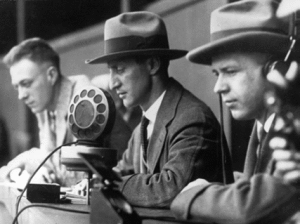
DETROIT, Feb. 28.— Harry Bannister, manager of WWJ, on Wednesday signed contracts with Socony-Vacuum Oil Company and General Mills as joint sponsors for direct broadcasts of all local Detroit Tigers baseball games, plus reconstructed broadcasts, based on direct-wire reports, of all out-of-town games. Sponsors are the same as last year, and carry on despite the auto situation, which has hit sponsors in this town hard.
New contract marks some kind of a record for Ty Tyson, who has broadcast games for WWJ for every season beginning in 1927, and will repeat for the 16th year. END
(Information and news source: Billboard; March 7, 1942).
![]()
 From the MCRFB radio news scrapbook: 1945
From the MCRFB radio news scrapbook: 1945
LOCAL PROGRAMMING HEDGES POSTWAR
Stations Go, Live in Hopes
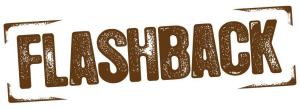 DETROIT (May 26, 1945) — Check of all major local stations indicates that emphasis on local programming is continuation of fairly long-time trend. In general, it has been something the stations has been doing for the last three years.Typically, WWJ has increased programming cost heavily in last two years, and WWJ has had a 73-piece symphony orchestra sponsored by a cut-rate department store for the two and a half years in a full hour Saturday night show with barely any mention of the sponsor.
DETROIT (May 26, 1945) — Check of all major local stations indicates that emphasis on local programming is continuation of fairly long-time trend. In general, it has been something the stations has been doing for the last three years.Typically, WWJ has increased programming cost heavily in last two years, and WWJ has had a 73-piece symphony orchestra sponsored by a cut-rate department store for the two and a half years in a full hour Saturday night show with barely any mention of the sponsor.
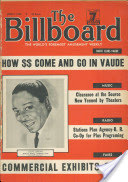
Trend is definitely continuing, with new developments, both commercial and sustaining, tending away from the all-platter shows, except in post-midnight and early-a.m. hours, where they appear to have a permanent useful place. WWJ for the last year has done a job with Nurses In Action, dramatizing the nurse recruiting campaign, and Victory Matinee, devoted each Wednesday afternoon to a different war effort cause and using the full talent resources of the station. Another show of typical operations here is Tenth Floor, Please, sponsored by a department store, which dramatizes the story of products sold on this floor.
In the last year, WJR pioneered in inter-station contacts for ideas, sending out five teams of station men, paired from different departments — typically the commercial manager and the program director — on one-week junkets around the country to inspect station operations in other cities.
Recently a swing quartet from the Motor Bar was put on the air for 15 minutes at 9:45 — at a cost of $65.00 daily — chiefly to break into the general soap opera schedule with something that wasn’t transcriptions, until change of schedule forced its abandonment.
Check on inter-station cooperation indicate this is largely by letter elsewhere. WXYZ, typically, reports frequent interchange of ideas, and requests for info on how the station has solved particular problems — such as what they do on department store programs. Most of these correspondence come from stations of the affiliated Blue. Station has made a practice of working closely on production with clients and agencies, in contrast to WJR, where the station typically done its own particular show packaging and then offered the product for sale.
Recorded programs on WXYZ have been reduced some 50 per cent in the past year — chiefly in favor taking net shows, rather than local production, in which the station was already strong, originating at least three week serials — notably Lone Ranger. Another trend toward better programming here is the move away from short records in favor of the larger disks with a full 15-minutes of music, or re-broadcasts.
The move toward better programming emphasis appears concentrated in smaller towns, typified by Michigan Radio Network, which has heavily moved this way within the past three months. END
(Information and news source: Billboard; June 2, 1945).
![]()
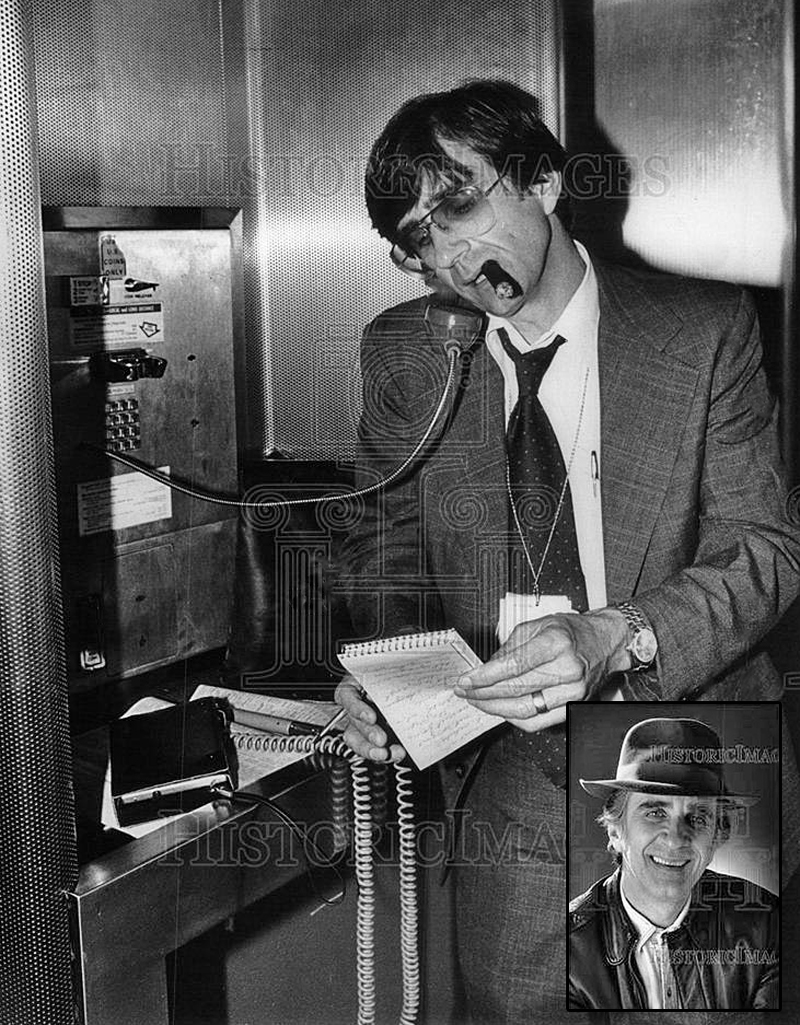
___
SADLY, WITH MUCH REGRET, Motor City Radio Flashbacks learned late-yesterday, former (Detroit radio) WXYZ, WWJ, and WXYT news reporter Tom McIntyre passed away Friday, October 2, 2015, in Venice, Florida.
His daughter, Kara McIntyre, stated he had been battling leukemia/lymphoma. He was 79. No funeral services will be held.
A memorial service for Tom McIntyre is planned for the first weekend in December, 2015, in Venice. A definite date as yet pending. McIntyre was part of the (ABC News) WXYZ 1270 news team here in Detroit during the 1960s.
Tom McIntyre. July 7, 1936 – October 2, 2015. R.I.P.
Press photo; 1981. Photo insert, right-bottom, courtesy of Lee Alan


![]()
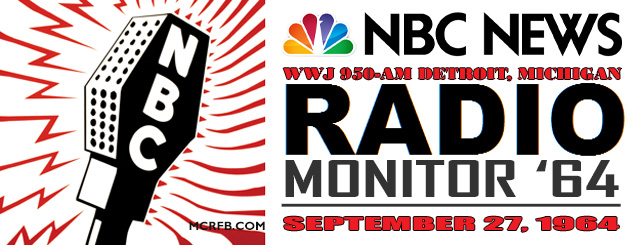
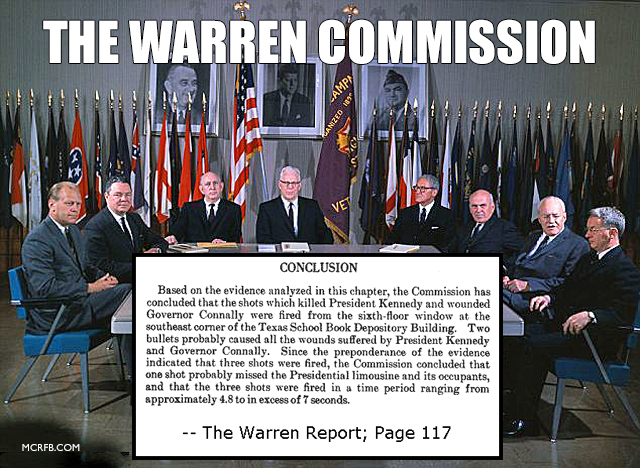
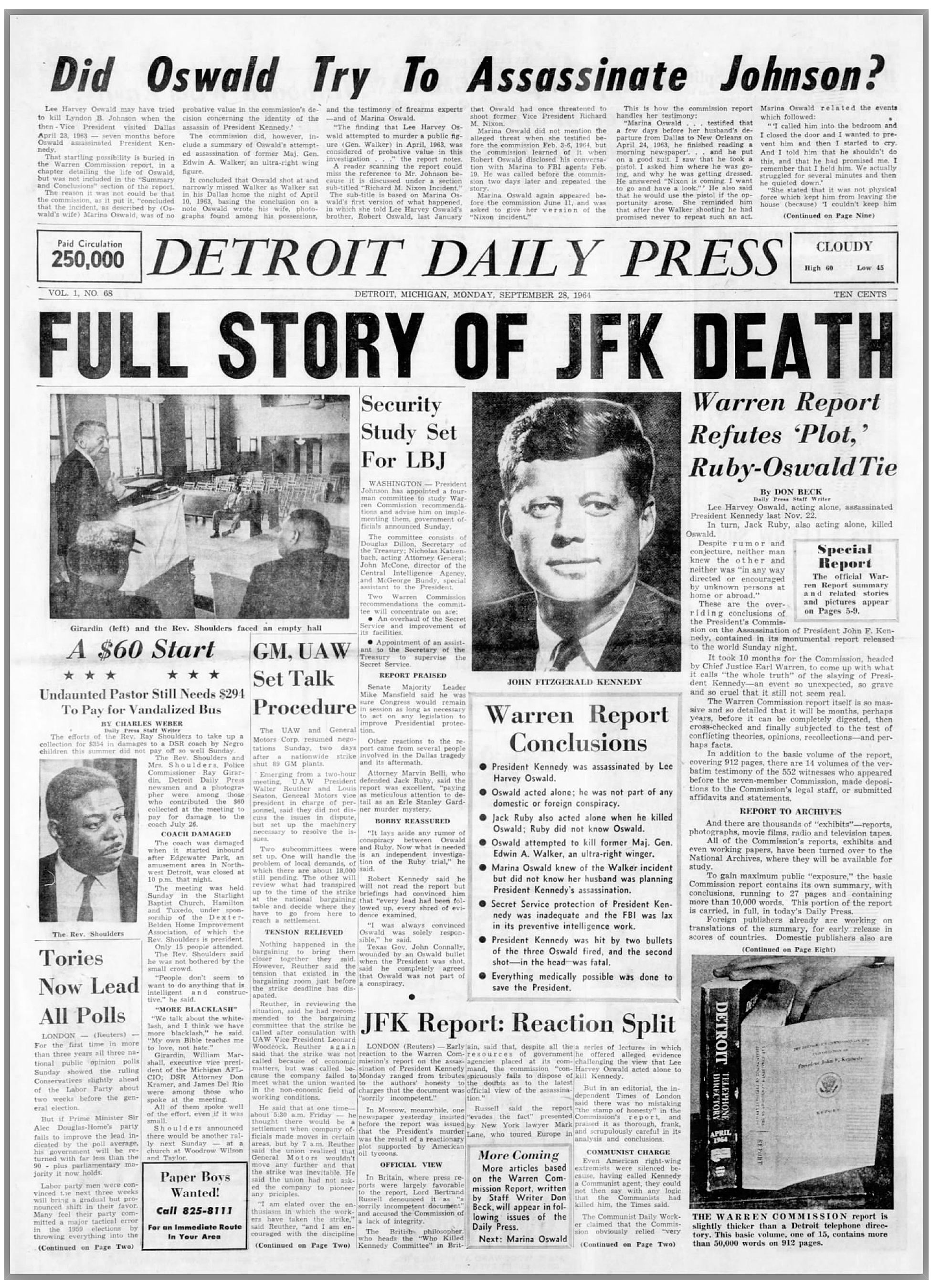
Note: The two major Detroit newspaper dailies were on strike during the time this substitute publication, DETROIT DAILY PRESS, was still in print in September 1964.
A MCRFB NOTE
WWJ-AM 950 was the NBC affiliate in Detroit in 1963. This NBC News “MONITOR ’64” commentary (by Frank Blair) coming out of New York, regarding the Warren Commission’s release of its much-anticipated report, was broadcast nationally on NBC Radio coast-to-coast. This ‘MONITOR ’64’ (Warren Report) special was aired in Detroit on WWJ 950, late Sunday night, September 27, 1964.

![]()
 From the MCRFB radio scrapbook pages: 1944
From the MCRFB radio scrapbook pages: 1944
Army Air Show Sold In Detroit; One Newspaper Plus Every Detroit Radio Station Breaks Records for 20-Day Military Shindig
 DETROIT (July 1, 1944) — The consistent, but most important use of radio by the army was the major factor in building an all-time record attendance for the Army Air Show. Turnstile clicked 2,100,000 in the 20 days ended Sunday (June 25). Show was sponsored by The Detroit Times and received general space there, naturally, but as The Times itself commented, it was just “not publicized” by the other newspapers. Practically all credit therefore for the large attendance goes to radio.
DETROIT (July 1, 1944) — The consistent, but most important use of radio by the army was the major factor in building an all-time record attendance for the Army Air Show. Turnstile clicked 2,100,000 in the 20 days ended Sunday (June 25). Show was sponsored by The Detroit Times and received general space there, naturally, but as The Times itself commented, it was just “not publicized” by the other newspapers. Practically all credit therefore for the large attendance goes to radio.
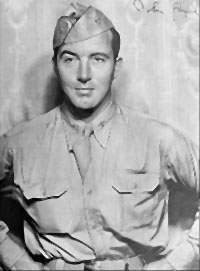
The show, staged five miles from town at the municipal airport, had a mile of exhibits under tent of Detroit-made (military) war products. Covered stage at the center of midway was used for on-the-ground shows and for the series of programs aired.
The Army Air Show set a record of three shows fed to national networks, three fed to regional networks and 52 local stations shows. Originating stations for the network shows were WXYZ, feeding the Blue and the Michigan Radio Net, and, WWJ, feeding the NBC-RED.
Local stations taking the shows were WJLB, WJBK, WJR, and CKLW. One show each was also fed to WTOL, Toledo, and to WCAR and WHK, Cleveland.
How Variety Shows Pull Best
Most consistent air show were Victory Varieties, opening five days in advance of the show on WJLB and broadcast through the entire run of the show. Program was variety with patriotic angles. Features of this, as of every practically show aired, was a combination of standard radio entertainment, with the casts of the radio station making the daily trip, via police escort, to the exhibit.

Among guest artists were Lt. William Holden and Pvt. John Payne, Hollywood stars; “Skeets” Gallagher, Benny Baker, and Gloria Humphrey, of Good Night, Ladies; Russell Swann, noted magician, and Norman H. Birnkrant, general counsel for the National Association of Theatrical Agents.
Numerous shows were not broadcast because of lack of air time. These were broadcast over the show’s P.A. system to all tents.
Reopening of the shows, which was closed four days because of a blow-down of fourteen big tents, was plugged by 35 spot announcements over various local stations.
Top accolades for the success of the radio program go to two former radio men, Lt. Col. J. Gordon Lloyd, and Staff Sgt. Arthur Sutton, assigned to the public relations office of the Sixth Service Command, Detroit Command, Detroit office. Lloyd was formerly account executive at WJZ, Blue Network, New York. Sutton was formerly production man and continuity writer at CKLW, WXYZ and WWJ, Detroit. END
(Information and news source, The Billboard; July 8, 1944).
DETROIT (July 1, 1944) — The Army Air Show, which featured a mile of tent exhibits of war products made in Detroit, closed a twenty-day span Sunday with attendance of 2, 100,000. Admission was free, but a check was made by General Motors and Ford Motor Company, principal exhibitors.
Sunday crowd reached about 300,000, second only to the opening Sunday, June 4, when it hit about 500,000. Mid-week attendance was down.
The factor points to a moral to shows playing in Detroit for the duration at least. The Motor City has become a 100 per cent weekend town, with amusements generally starving about four days a week, followed by turn-away crowds on weekends. END
(Information and news source, The Billboard; July 8, 1944).
![]()
 From the MCRFB radio scrapbook: 1943
From the MCRFB radio scrapbook: 1943
‘MANPOWER PAINS GROW’
Detroit Swings To “Ingenious Substitutes” For Solutions In Wartime WWJ, WJBK, CKLW
 DETROIT (May 29) — Despite the fact that the Motor City usually figures as the No. 1 manpower headache in the country, local radio stations are not too badly off in connection with announcing, sales and technical personnel. Several have resorted to ingenious substitutes or policies to meet the situation.
DETROIT (May 29) — Despite the fact that the Motor City usually figures as the No. 1 manpower headache in the country, local radio stations are not too badly off in connection with announcing, sales and technical personnel. Several have resorted to ingenious substitutes or policies to meet the situation.
In the background is the fact that Detroit attracts labor in all fields, and this goes for radio stations as well, by its glamour as an alleged high-standard learning center. There has never been a surplus of station jobs available, jobs so far has not exceeded demand.
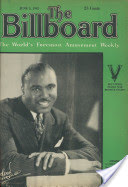
Generally typical is the set-up at WWJ, NBC station, and the only one to turn to female announcers — they now have two femme gabbers and one girl newscaster. Reaction from the public has been favorable, according to Edwin K. Wheeler, assistant manager. However, the station is not committed to femmes unless they have to — they hired two more male announcers in the past two weeks. It is figured that the leaving of ladies on the staff will help if and when the femmes take over all the way. This may happen in a few months with the drafts of fathers, into which class most of the announcers now fall.
Fertile Sources Closed
The commercial staff of WWJ has not been touched by the draft yet, but has only three men, since most of the selling is done by the net anyway. They expect to lose two of the three, by August 1, and will probably get along with the remaining salesmen.
On the engineering side, WWJ has been able to meet the loss of men without difficulty so far, by drawing in skilled men from other fields. One source, now closed, was the smallest station, but with WMC rulings on job freezes particularly effective in this “essential” industry and especially in the Detroit labor region, this avenue appears about closed without extraordinary special exemptions in an emergency case.
WWJ got one good technical man who was formerly a radio serviceman, despite the shortage of serviceman in this city. Another replacement was formerly a radio “ham” operating his own station. These sources are about exhausted now.
WJBK, typical of the smaller stations, has lost two salesmen and three announcers, with another set to go in a week. They are having their salesmen double-up, and are getting by in the commercial department. So far, enough new announcers have been forthcoming to meet the situation, but the station is using five woman as monitors on foreign-language programs, covering 13 different languages.
Draft Free Breaks
The technical staff has not been touched at WJBK. Although there has been no deliberate policy, N. W. Hopkins commented that “We never figured that a handicap should be discriminated against if a man has the technical ability.” The result is a large proportion of F-4 men and the willingness now to employ any more they can get. In addition, WJBK has some technical men with pre-Pearl Harbor dependents, who has so far been draft exempt.
At CKLW, the situation is peculiar in that the station has studios in Detroit, but has its transmitter and other studios in Windsor, Ontario, and comes under Canadian regulations. The technical staff has been little affected as yet, according to Richard E. Jones, sales promotions manager, who said that “Canadian regulations have evidently given considerable thought to the requirements of the broadcast industry. It looks as though they were a little more liberal in granting deferments where an industry is of public importance.”
The station has lost two salesmen, four engineers and four announcers. The sales situation is being met by older men, and Jones commented that “We will probably have to expect a trend toward the employment of older men than has been usual in radio.”
Public Against Gals
On announcers, sentiment at CKLW appears to be rather against the use of women announcers. This is based on a study of public reactions to the use of females at other stations, Jones said, though it may, in part, be due to unfamiliarity. CKLW, meanwhile, will try to get by with present announcers doubling up on duties.
Up until the past few weeks, local stations were able to attract staffmen from other cities, both small and large, with good scales of pay in effect here. A new type of difficulty recently became critical when one station lost an announcer from Chicago who preferred to go back to free-lancing there, when he was unable to get rooms to house his wife and family in Detroit after six months of trying. END
(Information and news source: Billboard; June 5, 1943).
![]()
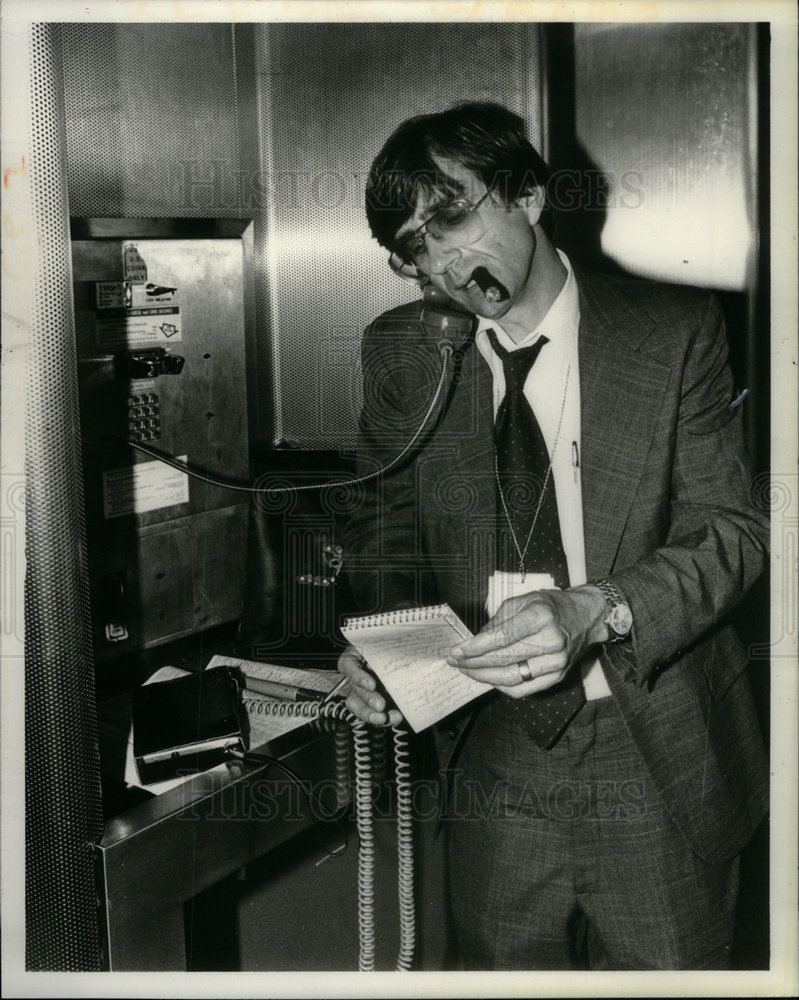
![]()
 From the MCRFB radio scrapbook: 1947
From the MCRFB radio scrapbook: 1947
Detroit Stations In Publicity Shifts
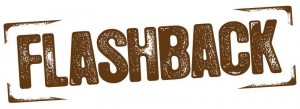 DETROIT, July 12 — Radio publicity staffs of major local radio stations were somewhat scrambled this week, with James Quello, publicity director at WXYZ, ABC-owned station, moving over to WJR, where he assumes the combined posts of advertisement and publicity July 14. Quello replaces Bob Anthony, the first man to hold down this specific assignment when the WJR staff underwent earlier organization changes. Anthony is understood to have had several other offers.
DETROIT, July 12 — Radio publicity staffs of major local radio stations were somewhat scrambled this week, with James Quello, publicity director at WXYZ, ABC-owned station, moving over to WJR, where he assumes the combined posts of advertisement and publicity July 14. Quello replaces Bob Anthony, the first man to hold down this specific assignment when the WJR staff underwent earlier organization changes. Anthony is understood to have had several other offers.
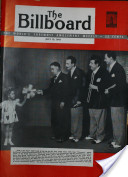
At the same time, Loren C. (Bud) Watson resigned as publicity director at WWJ, effective July 19, and will open an independent publicity office. No successor has yet been appointed.
Further major row shift rumored was that of Harry Heilmann, sportscaster at WXYZ, who is reported slated for a sports director’s post at WJR.No confirmation on this report could be obtained but it was further inferred, on the basis of the rumored report, that WJR would take over ply-by-play broadcasts of the Detroit Tigers game next season. END.
(Information and news source: Billboard; July 19, 1947).
![]()